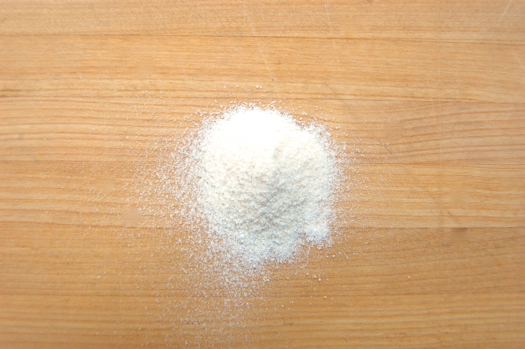Pectin

Pectins are long-chain sugars that are found in the cell walls of plants, most especially in the walls of fruit cells. There they create a sort of elastic, moisture-retaining barrier and also function as a glue that holds the cells together. Pectins are especially abundant just before fruits are at peak ripeness. When fruit is cut up and/or mashed and then immersed in hot water the pectins come loose, dissolve and disperse. Under the right conditions those sugars can be brought back together into a flow-preventing network, but it takes a little coaxing since pectins repel each other in pure water. Acid generally does the trick as it changes the molecules’ polarity and encourages them to bond.
Pectin is most often used as a thickener for jams since a.) it’s already there to begin with and b.) a fruit mash for a jam is usually acidic, and if it isn’t naturally it’s made so with the addition of lemon juice. Jam works by gently boiling the fruit in a heavy syrup to dislodge and dissolve the pectins. At the same time the sugar in the mixture binds up a good deal of the water thus putting the pectins in closer proximity. When the syrup is thick enough acid is added and the gel shortly forms. The finished jam is then cooled and allowed to set.
Here it’s important to point out that pectin can’t take a whole lot of heat AND acidity in concert. If the boiling goes on longer than a few minutes the pectins start to break into pieces, the flow-inhibiting network breaks down and the jam thins out again. This is why traditional jam-making can be difficult, at least when it comes to judging when the syrup is thick enough and/or when the gel has formed. Too much boiling past the gelling point and you get fruit syrup. Which is still darn good.
Is jam the only thing pectin is good for? No, but because it requires both acid and heat to activate — plus a fairly high concentration — it’s not as useful as many other commonly available thickeners.
Any chance of getting you to go into more depth on pectin? For example, we’ve found we like Pomona’s Universal Pectin (http://www.pomonapectin.com/) since it requires less sugar to set. You can make a jam with no added sugar and still get a good set, unlike the overly sweet (to our taste) jams you get with traditional fruit-based pectins.
Hey Thespian!
You’re very right. The newer pectins thicken without much sugar. Traditionally in order to get a firm pectin gel the jam had to be very acidic and high in non-water molecules like sugar — about 60%. These pectins have what’s called a “high DM” (methoxylation) value. The the higher the DM value, the more sugar and acid you need to get the pectin molecules to bond and the mesh to form. Newer low-DM value pectins don’t need much acid or sugar to gel. In their case, calcium ions are the things that facilitate the bonding and the resulting thickening. These pectins have made a whole new world of low-sugar jams possible, which have been a boon to both dieters and diabetics!
Does that help?
– Joe
So what does pectin get used in *other* than jam/jelly? I can’t say I’ve ever seen anything else that calls for it…although I suppose some things made with fruit incidentally contain pectin?
Hey Jane!
These days pectins are used in all sorts of things. They’re commonly used to stabilize yogurts, both the thick and the drinkable kind. They thicken fruit and cream fillings and are used to give beverages “body”. I’m sure there are other applications, I’m just not thinking of them.
Thanks for a great question!
– Joe
You answered a question I had from my jam-making experience. Most jam recipes which call for added pectin emphasize that you cannot double the recipe, and my experience trying it usually results in jam that does not “set” or thicken. It now makes sense – the larger volume could very well take more time to heat, which means that the pectin may be breaking down as the mixture is coming to temperature, and being processed in a boiling water bath.
That’s a great insight, Cynthia! I’ll be that is indeed the reason.
Cheers and thanks!
– Joe
Hi Joe,
I am making a tarte with a ‘filling’ which involves heating 1/2 cup of heavy cream until steaming, before adding 2 tsps gelatin that has been dissolves in 2 tbsp ice water. Stir for a minute then add cream mixture to 1 1/2 cups of greek style yoghurt that has been sweetened with 1/4 cup light brown sugar. Pout mixture into tart crust and set in refrigerator hours or overnite.
My problem is I have medical issues with gelatin. I have powdered pectin as well as cornstarch at home. Can you tell me how I could substitute either of these thickeners in my tart base? Which would be preferable? And how much should I use (I understand that I would need to play with this but would like to get your recommendations first)?
Thanks so much for your help, I have been searching all over for help on this but am having trouble finding direction with this.
Hi Kim!
Agar agar is a very easy gelatin substitute. Sprinkle it over the cream in the pan when it’s cool. Heat the mixture to the boiling point and proceed as directed!
Cheers and best of luck with the project!
– Joe